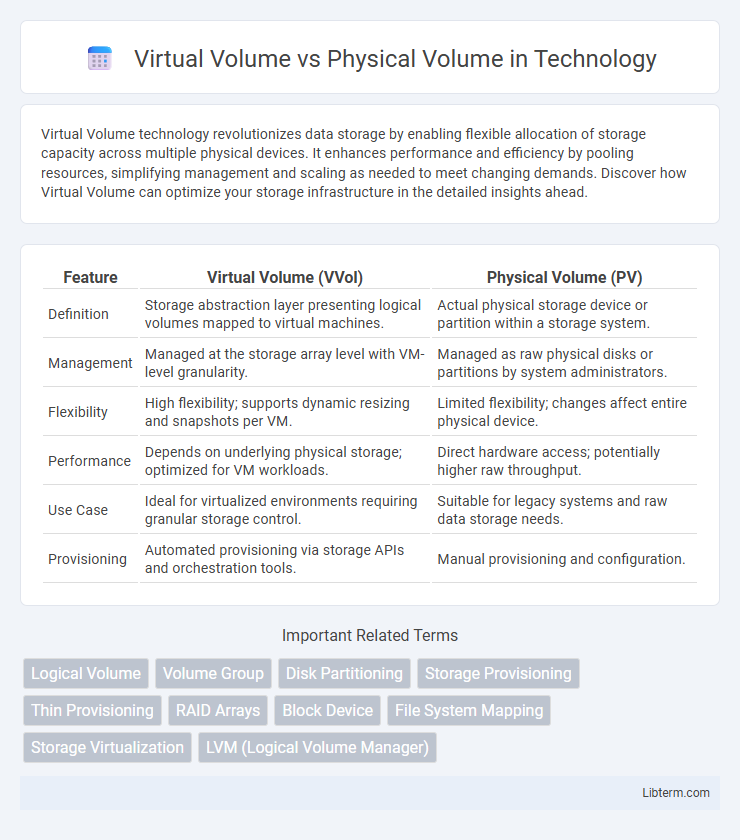Virtual Volume technology revolutionizes data storage by enabling flexible allocation of storage capacity across multiple physical devices. It enhances performance and efficiency by pooling resources, simplifying management and scaling as needed to meet changing demands. Discover how Virtual Volume can optimize your storage infrastructure in the detailed insights ahead.
Table of Comparison
| Feature | Virtual Volume (VVol) | Physical Volume (PV) |
|---|---|---|
| Definition | Storage abstraction layer presenting logical volumes mapped to virtual machines. | Actual physical storage device or partition within a storage system. |
| Management | Managed at the storage array level with VM-level granularity. | Managed as raw physical disks or partitions by system administrators. |
| Flexibility | High flexibility; supports dynamic resizing and snapshots per VM. | Limited flexibility; changes affect entire physical device. |
| Performance | Depends on underlying physical storage; optimized for VM workloads. | Direct hardware access; potentially higher raw throughput. |
| Use Case | Ideal for virtualized environments requiring granular storage control. | Suitable for legacy systems and raw data storage needs. |
| Provisioning | Automated provisioning via storage APIs and orchestration tools. | Manual provisioning and configuration. |
Introduction to Virtual and Physical Volumes
Virtual volumes (VVols) streamline storage management by abstracting physical storage into logical units, enabling granular control and automation in virtualized environments. Physical volumes (PVs) represent the actual, raw storage devices like hard drives or SSDs, providing the foundational hardware layer for data storage. VVols enhance flexibility and scalability by decoupling virtual machine storage requirements from the constraints of traditional physical volume configurations.
Defining Virtual Volume: What Is It?
A virtual volume is a logical storage unit created by abstracting and pooling physical storage devices, enabling more flexible and efficient data management. Unlike physical volumes, which are tied to specific hardware, virtual volumes allow dynamic allocation and reallocation of storage resources without direct dependence on physical disks. This abstraction enhances scalability and simplifies storage provisioning in virtualized environments.
Understanding Physical Volume: Core Concepts
Physical Volume (PV) in storage refers to the actual physical hard drives or partitions that serve as the foundational building blocks of a Logical Volume Manager (LVM) system. It provides the raw storage space that is aggregated into Volume Groups, enabling flexible volume management and resizing. Understanding PV is crucial for managing disk space allocation, as it directly impacts the performance, scalability, and reliability of virtual volumes created within the LVM framework.
Key Differences Between Virtual and Physical Volumes
Virtual volumes (VVols) provide granular storage management at the virtual machine level, offering improved efficiency and flexibility by abstracting storage resources without the need for entire physical disks. In contrast, physical volumes represent actual, dedicated storage devices or partitions directly attached to the host, ensuring predictable performance but limited scalability. Key differences include VVols enabling policy-driven automation and dynamic provisioning, while physical volumes require manual configuration and lack application-level insight.
Use Cases for Virtual Volumes
Virtual Volumes (VVols) provide granular storage management by enabling virtual machine-level control, optimizing performance and capacity utilization in dynamic environments. Use cases for VVols include disaster recovery, where seamless integration with storage arrays allows efficient snapshot and replication at the VM level, and DevOps workflows, benefiting from on-demand provisioning and rapid cloning without storage overhead. VVols enhance cloud and hybrid cloud deployments by simplifying storage operations and enabling policy-driven automation tailored to individual VM requirements.
Practical Applications of Physical Volumes
Physical volumes serve as the foundational storage units in Logical Volume Management (LVM), enabling flexible disk space allocation by aggregating multiple physical disks into a single volume group. They allow system administrators to enlarge, reduce, or move volumes dynamically without downtime, essential for managing growing data in enterprise environments. Common practical applications include improving storage efficiency in servers, enabling snapshot creation for backups, and simplifying disk management in virtualized infrastructures.
Performance Comparison: Virtual vs Physical Volume
Virtual volumes offer improved flexibility and scalability by abstracting storage from physical hardware, but they may introduce slight latency due to virtualization overhead. Physical volumes provide direct access to storage devices, resulting in lower latency and higher throughput for performance-critical applications. Performance differences become more noticeable in high I/O environments where physical volumes typically outperform virtual volumes due to reduced processing layers.
Security Considerations for Each Volume Type
Virtual volumes offer enhanced security features such as encryption at the software layer, allowing granular access control and easier isolated data management compared to physical volumes. Physical volumes rely heavily on hardware-based protection mechanisms like SED (Self-Encrypting Drives) but can be vulnerable if physical access controls are weak. Understanding the security implications of each volume type is crucial in designing a robust data protection strategy that balances performance and risk mitigation.
Scalability and Flexibility Analysis
Virtual volumes offer superior scalability by enabling dynamic storage allocation and easy resizing without physical hardware changes, supporting evolving workload demands more efficiently than physical volumes. Physical volumes, constrained by fixed hardware capacities, require manual upgrades and physical expansion to scale, limiting responsiveness to rapid growth. Flexibility is enhanced in virtual volumes through seamless integration with cloud environments and automation tools, allowing quick reconfiguration and optimized resource utilization unmatched by traditional physical volume management.
Choosing Between Virtual and Physical Volume: Which Is Best?
Choosing between virtual and physical volume depends on storage flexibility and performance needs; virtual volumes offer dynamic allocation and efficient space utilization ideal for scalable environments, whereas physical volumes provide direct hardware access ensuring maximum speed and reliability. Virtual volumes simplify management by abstracting storage resources, reducing hardware dependence, while physical volumes excel in high-throughput applications requiring dedicated storage media. Evaluating workload characteristics and infrastructure compatibility is crucial to determine the optimal balance between cost, scalability, and performance for your storage solution.
Virtual Volume Infographic

 libterm.com
libterm.com